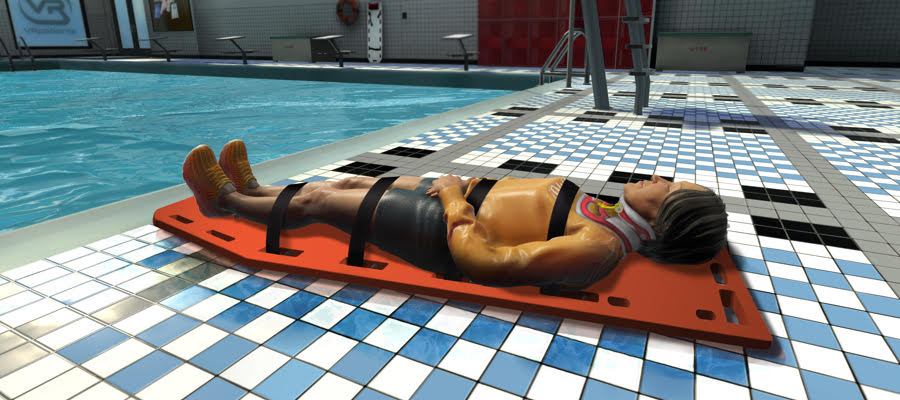How to Maximize EMS Training Budgets with Virtual Simulation
As budgets tighten due to COVID-19, EMS Trainers are facing looming questions at fiscal year-end: How do we maximize training spend? As its the 4th quarter of 2020, it’s probably time to start taking a hard look at where your ems simulation training budget stands and how to spend your precious remaining training dollars. For many governments, tax revenues have fallen and they’re facing tough choices about how to allocate precious resources. Serendipitously, there are new EMS simulator training tools to help us maximize our spends; specifically, with virtual reality (VR) technologies.
“When we’re facing limited resources, we need to learn to react quicker, smarter, and better,” says Duane Ginder, an experienced EMS worker, educator, and manager who serves as an EMS subject matter expert for VRpatients, a virtual training platform that provides virtual online simulation training for emergency medical workers.
The hard truth is that we are all trying to stay afloat, with less. We need to explore every possible tool available to help us overcome our clinical training challenges. While some laggards will hold fast against new technologies, the world currently leaves us very little in the means of options. Overcoming any initial technical or operational hurdles for installing such tools is a band aid that simply just needs to be ripped off. The good news is, its easier than you think and more effective than ever before.
Sponsored Content:
States Facing Budget Shortfall
Budget forecasting for 2021 certainly won’t be easy. According to a Center on Budget and Policy Priorities report, state budget shortfalls could total $555 billion dollars in the next two years, with a $290 billion loss next year alone. These staggering numbers do not include local governmental budget shortfalls.
The report also says during four months of 2020, state and local governments laid off 1.5 million workers.
“The risk of losing a trained coworker is having to replace them with someone who isn’t properly trained, which can be very costly,” Ginder says. “What you’re trying to do is get them field experience which they haven’t been exposed to. With healthcare simulation applications like VRpatients, trainers can get practitioners into some of those real-life situations without the risks associated with actual patient care in the field.”
Sponsored Content:
Sadly, departments will have to do much more with less. “It’s important to recognize that with a less experienced workforce, you have to do more simulated training and so your cost really goes up,” Ginder explains, adding all departments are looking for ways to bring their costs down. “You want to be able to reproduce the training and get it to your people as quickly as possible.”
EMS Training Still Necessary Even In Budget Crisis
Even with budget problems, EMTs and other emergency workers still need training to expose them to things they might not see every day, but must still be ready to deal with.
“We have the high risk and low frequency things that people can be exposed to, but rarely are. You try to expose them through training, but unfortunately when you do it with mannequins in simulated situations, it’s hard to get that realism,” Ginder says. “Organizations have to look at doing things differently with the resources they have and that’s where they’re trying to maximize their training dollars to reach their masses to get them uniform training. It takes a long time and effort to set up a mannequin-based training scenario for just a few people to go through at a given time.”
With VRpatients for example, trainers can build their own clinical case simulation scenario and modify the patient’s conditions or treatment protocols to meet their medical simulation training requirements.
Simulation Training For Pre-Employment Screening
Making sure job candidates are good for your organization is also important as new EMS workers enter the workforce.
“You’re investing a couple of months of training into somebody, you want to make sure you’re making the right choice,” Ginder says, adding you don’t want to invest time and money into someone only to have them not be a good fit. “I was just talking to an organization that is using VRpatients to screen new employee candidates to help them figure out who will be best suited for the organization.”
EMS agencies as well as training organizations need to make the recertification and training processes as cost-effective as possible both for the agency and the student. Tools like VRpatients, an online virtual and immersive training environment, can help reduce training costs and still provide the lifelike situations each student needs to learn.
“You want all of your workers to receive the same training because you can’t be selective with limited resources about who gets sent on which call.” Ginder warns. Virtual training can help keep things the same for everyone while keeping the financial investment as low as possible. “With VRpatients, we can build thought-provoking and difficult virtual patient scenarios and train on a web-based platform which is much easier and cheaper than trying to get everyone into a single location.”
End of Federal Fiscal Year Approaching
The time is right to invest in virtual training. The end of the Federal fiscal year is just days away and unless you are getting a no-cost extension for any Federal grants, the money is usually use-it-or-lose-it.
As an industry leader navigating the remote learning world, the people at VRpatients know you are always looking to optimize your educational toolset. VRpatients increases knowledge retention and builds stress inoculation, all for a fraction of the price of traditional sim training.
Contact VRpatients to schedule a demo or to learn more about how VRpatients can help you get the most out of your precious training dollars!
Learn More by Visiting the VRpatients Website Today!
Lance Baily, BA, EMT-B, is the Founder & CEO of HealthySimulation.com, which he started while serving as the Director of the Nevada System of Higher Education’s Clinical Simulation Center of Las Vegas back in 2010. Lance is also the Founder and acting Advisor to the Board of SimGHOSTS.org, the world’s only non-profit organization dedicated to supporting professionals operating healthcare simulation technologies. His co-edited Book: “Comprehensive Healthcare Simulation: Operations, Technology, and Innovative Practice” is cited as a key source for professional certification in the industry. Lance’s background also includes serving as a Simulation Technology Specialist for the LA Community College District, EMS fire fighting, Hollywood movie production, rescue diving, and global travel. He and his wife Abigail Baily, PhD live in Las Vegas, Nevada with their two amazing daughters.
Sponsored Content:




















